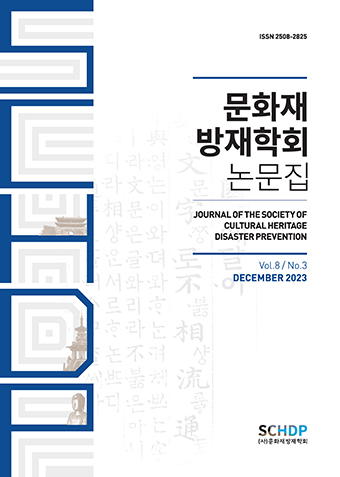Article
Abstract
References
Information
As for the fire hazard of cultural properties of wooden structures in Korea, there have been continuous cases of fire loss in national treasures such as Geumsansa Temple in 1986, Guryongsa Temple in 2003, Naksansa Temple in 2005, Changgyeonggung Palace in 2006, Bulguksa Temple in 2007, and Sungryemun in 2008. In this study, structural parts vulnerable to fire spread were identified through fire simulation tool, and the fire hazard in the structural parts before and after flame-retardant treatment was evaluated for Sungnyemun and Bulguksa Daeungjeon, which are open and closed wooden structures, respectively. As a result, no flashover occurred in both Daeungjeon of Bulguksa and Sungnyemun, which had been treated with flame retardant treatment. At 200 seconds after ignition, Daeungjeon of Bulguksa was less than 50MW and that of Sungnyemun was less than 10MW, which was 3.4~6.44 times lower than before flameproofing. and the maximum temperature was below 800 °C, confirming that flame growth was controlled.
우리나라 목조건축물은 1986년 금산사, 2003년 구룡사, 2005년 낙산사, 2006년 창경궁, 2007년 불국사, 2008년 숭례문 등 국보 문화유산에서 끊임없이 화재로 인한 소실사례가 발생하고 있어 높은 화재위험성을 보인다. 화재에 취약한 목조건축물에 대한 화재확산 예방의 차원에서 소화관련 자동화 설비 뿐만 아니라 목재재료의 화재확산을 지연시키는 방법에 대해 더욱 적극적인 실행도구가 필요하다. 본 연구에서는 화재시뮬레이션을 통해 화재확산에 취약한 구조부를 확인하고 이 구조부의 방염처리 효과에 대해 개방형과 밀폐형 목조건축물인 숭례문과 불국사 대웅전에 대해 평가하였다. 그 결과, 방염처리한 불국사 대웅전과 숭례문 모두 플레쉬오버는 발생되지 않았으며 발화 후 200초 경과지점에서 불국사 대웅전은 50MW이하, 숭례문에서는 10MW급 이하로 방염처리 전에 비해 3.4~6.44배 낮은 화재강도를 나타내었고 최대 온도는 800°C 이하로 나타나 화염성장이 제어되는 것을 확인하였다.
- Corentin Macqueron (2014). “Computational fluid dynamics modeling of a wood-burning stove-heated traditional Sauna using nist’s fire dynamics simulator.” Corentin Macqueron, Computational Fluid Dynamics Engineer, pp.1-9. 10.1142/9789814623728_0001
- Gyeongju-si (2017). “Report on the painting pattern and precise survey about Daeungjeon-hall of Bulguksa temple” Gyeongju-si Service Report, p.633.
- Kang, S.-H. (2001). “Computer aided reconstruction of a destroyed ancient building : Daewoongjun in Bulguk- temple-” Paper for Master Degree, Ewha University, p.92.
- Kim, D.-H., et al. (2006). “A Study of Calory Analysis Methods about Surface Fire Fuel.” J. of Korean Institute of Fire Sci. & Eng., Vol.22, No.3, pp.258-264.
- Kim, D.-H., Jo, S.-S., Kim, S.-H., Lee, S.-G. (2020). “A Study on Fire Vulnerability Analysis of Wooden Cultural Property Using Fire Simulation - For Bulguksa Temple -.” Journal of the Society of Cultural Heritage Disaster Prevention, Vol.5, No.3, pp.233-242.
- Kim, H.-J., Oh, K.-H., Lee, S.-E. (2009). “A Study on the Flame Resistance Performance with the Flame-Resistance Paints Treatment of the wood.” Proceedings of the Korea Institute of Fire Science and Engineering Spring Conference, pp.396-403.
- Kim, S.-Y., Shin, Y.-J., Park, Y.-J., Lee, H.-P. (2008). “A Study on Fire Risk Assessment of the Temple Using Fire Loads.” Proceedings of the Korea Institute of Fire Science and Engineering Conference, pp.409-415.
- Korea Institute of CIivil Engineering and Building Technology (KICEBT) (2020). The Development of Fire Risk Assessment Method with Fire Vulnerability of Building (2/3), KICT Report KICT 2020-116, pp.73-75
- Seoul Metropolitan Fire & Disaster Headquartors (2008). -Seoul Sungryemun- Arson Investigation Report, pp.1-56.
- SFPE (2016). SFPE Handbook of Fire Protection Engineering, 5th edition, p.3493.
- Song, Y.-J., Gu, S.-H. (2016). “A Study on the Fire Alarm System of Vertical Fire Spread Structure by Using FDS.” J. of Korean Institute of Fire Sci. & Eng., Vol.30, No.5, pp.100-107. 10.7731/KIFSE.2016.30.5.100
- Publisher :The Society of Cultural Heritage Disaster Prevention
- Publisher(Ko) :문화재방재학회
- Journal Title :Journal of the Society of Cultural Heritage Disaster Prevention
- Journal Title(Ko) :문화재방재학회논문집
- Volume : 8
- No :3
- Pages :211-218



 Journal of the Society of Cultural Heritage Disaster Prevention
Journal of the Society of Cultural Heritage Disaster Prevention




